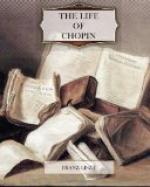Zal! In very truth, it colors the whole of Chopin’s compositions: sometimes wrought through their elaborate tissue, like threads of dim silver; sometimes coloring them with more passionate hues. It may be found in his sweetest reveries; even in those which that Shakespearian genius, Berlioz, comprehending all extremes, has so well characterized as “divine coquetries”—coquetries only understood in semi-oriental countries; coquetries in which men are cradled by their mothers, with which they are tormented by their sisters, and enchanted by those they love; and which cause the coquetries of other women to appear insipid or coarse in their eyes; inducing them to exclaim, with an appearance of boasting, yet in which they are entirely justified by the truth: NIEMA IAK POLKI! “Nothing equals the Polish women!” [Footnote: The custom formerly in use of drinking, in her own shoe, the health of the woman they loved, is one of the most original traditions of the enthusiastic gallantry if the Poles.] Through the secrets of these “divine coquetries” those adorable beings are formed, who are alone capable of fulfilling the impassioned ideals of poets who, like M. de Chateaubriand, in the feverish sleeplessness of their adolescence, create for themselves visions “of an Eve, innocent, yet fallen; ignorant of all, yet knowing all; mistress, yet virgin.” [Footnote: Memoires d’Outre Tombe. 1st vol. Incantation.] The only being which was ever found to resemble this dream, was a Polish girl of seventeen—“a mixture of the Odalisque and Valkyria...realization of the ancient sylph--new Flora—freed from the chain of the seasons” [Footnote: Idem. 3d vol. Atala.]—and whom M. de Chateaubriand feared to meet again. “Divine coquetries” at once generous and avaricious; impressing the floating, wavy, rocking, undecided motion of a boat without rigging or oars upon the charmed and intoxicated heart!
Through his peculiar style of performance, Chopin imparted this constant rocking with the most fascinating effect; thus making the melody undulate to and fro, like a skiff driven on over the bosom of tossing waves. This manner of execution, which set a seal so peculiar upon his own style of playing, was at first indicated by the term ‘tempo rubato’, affixed to his writings: a Tempo agitated, broken, interrupted, a movement flexible, yet at the same time abrupt and languishing, and vacillating as the flame under the fluctuating breath by which it is agitated. In his later productions we no longer find this mark. He was convinced that if the performer understood them, he would divine this rule of irregularity. All his compositions should be played with this accentuated and measured swaying and balancing. It is difficult for those who have not frequently heard him play to catch this secret of their proper execution. He seemed desirous of imparting this style to his numerous pupils, particularly those of his own country. His countrymen, or rather his countrywomen, seized it with the facility with which they understand every thing relating to poetry or feeling; an innate, intuitive comprehension of his meaning aided them in following all the fluctuations of his depths of aerial and spiritual blue.




